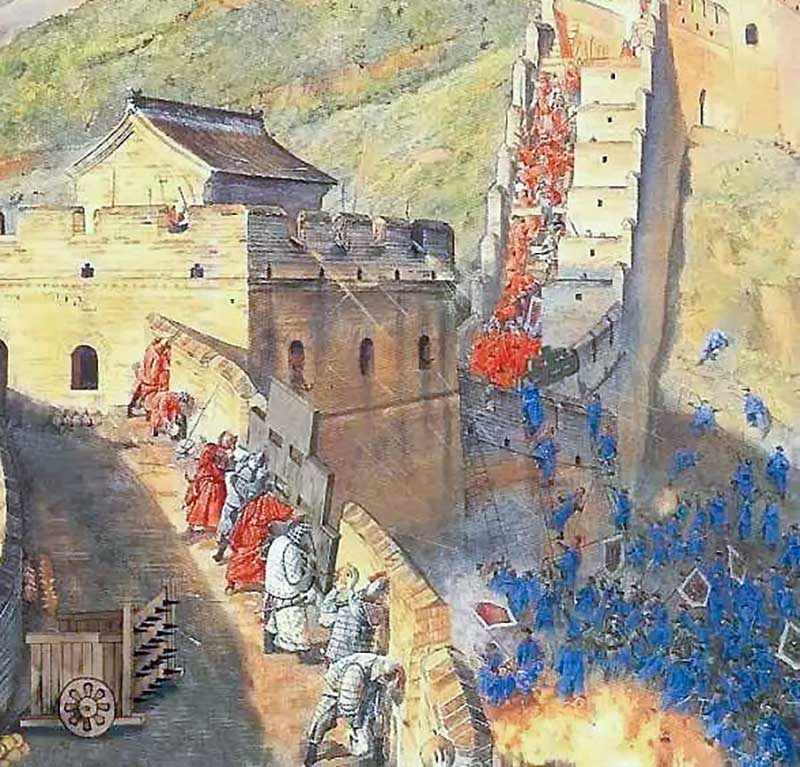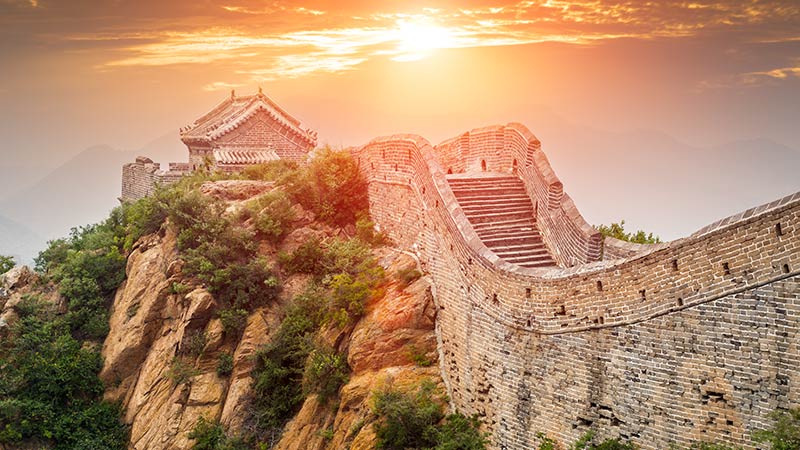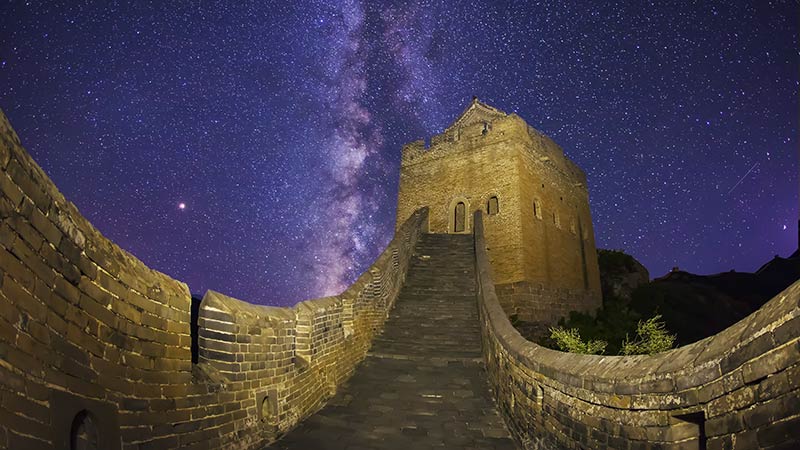Great Wall of China: Things to do in Beijing, China
Mention the Great Wall of China and instantly a picture springs to mind of perhaps China’s most iconic landmark, which is no small accolade given the rich trove of cultural treasures to be found all over the country. So significant is the Great Wall that UNESCO listed it as a World Heritage site in 1987, and there would be just a tiny percentage of travelers to China who wouldn’t scale the wall while visiting Beijing.
But there is more to the Great Wall of China than myths like it is the only landmark on Earth that can be seen from space. In fact, the history of the Great Wall is as long and rich as the structure itself. Apart from being a symbol of China – visionary, enduring, and practical – the Great Wall is also a demonstration of the country’s spirit.
Before making your way to the top of the wall, it pays to understand a little of what’s behind its creation because it will make for an even more enriching adventure when you’re there.
Great Wall of China: Important facts
In typically descriptive form, the Chinese name for the Great Wall is translated as ‘10 thousand mile long wall’ (万里长城). Construction of the wall commenced during the Spring and Autumn and Warring States period, which occurred between 770 BC and 221 BC.
In fact, the name ‘Great Wall’ is a little deceptive, because the wall is in fact a massive defense system. It combines city walls, watch towers, passes, beacon towers, enemy forts, barriers, ramparts, fortresses, and ditches and spans a breathtaking 6,700 kilometers across 15 provinces and cities, including Hebei, Beijing, Tianjin, Shanxi, Shaanxi, Gansu, and others. Winding through the northern and middle part of China from the Shanhai Pass in the east to Jiayu Pass in the west, there is absolutely no doubt the wall is a remarkable feat of construction. While large amounts of the wall have deteriorated or destroyed, there is no doubt as to its significance in history.
Construction of the Great Wall

Construction of the Great Wall commenced during the Spring and Autumn and Warring States Period, well over 2,000 years ago. Very much a defense system, it was prompted by the various warring states wanting to protect their respective land and cities. Huge walls seemed to be the obvious answer. However, the effectiveness of the individual defense systems was tested in 221 BC when the Qin states, the strongest of all seven, defeated and unified the disparate entities.
Effectively forming China’s first dynasty, Emperor Qin Shihuang set about bringing his grand vision to life. Among the measures he enforced was centralization of power, standardization of language across the country, and construction of connecting walls between the existing walls. We do not know how many people were involved in the construction. Numbers vary, depending on the period during which construction took place. What we do know is the workforce included soldiers, peasant laborers and convicts, and the physical hardship endured led to the death of many on site. The result of this massive exercise formed the basis of the Great Wall we know today.
That said, it is misleading to think that’s where the Great Wall started and stopped, because it doesn’t. The Great Wall extends well beyond Emperor Qin’s grand plan. Since that initial enhancement, the wall has undergone almost continuous construction. Subsequent dynasties and states have added their own unique touches to the wall. It was during the Han dynasty (202 BC – 220 AD) in particular that the longest stretch was built.
In much the same way that the wall weaves throughout China, it’s development is intricately bound to the country’s evolution. Take the famous Silk Road. Around half the route of the Silk Road, which forged a commercial and cultural pathway through China, was established and ran alongside the Great Wall.
While every dynasty sought to make its mark on the wall, few were as prolific in their construction as the Ming dynasty (1368 – 1644), during which a massive 20 huge development projects were initiated. Incredible!
Without question, the Great Wall ranks among the world’s great construction projects. In large part, the wall was built by hundreds of thousands of people who shaped the bricks and earth that give it form. It is for this reason, the Chinese saying ‘He who does not reach the Great Wall is not a true man’ holds such significance among local people.
Unsurprisingly, the main parts of the Great Wall were built on top of mountains, endlessly winding over ridges, and in many ways, shaping the landscape to take on a likeness to that much revered Chinese symbol of power, the dragon.
The Great Wall today: A must-see thing to do in Beijing

Although the Great Wall covered a massive amount of territory throughout China, there are many parts of it which have fallen into disrepair. In fact, in some places, the existence of the wall isn’t recognizable, which is one very good reason to make it a must-see thing to do in Beijing.
The Great Wall we can see today was built mostly during the Ming Dynasty. Beijing, as a destination that is on the bucket list of most first time visitors to China, is perhaps the most accessible of destinations to climb the wall, however it’s not the only one. Fortunately, there are many sections of the Great Wall open to the public.
| Beijing | Best for visiting Badaling, Mutianyu, Juyongguan, Jinshanling and Simatai sections |
| Tianjin | Stay in Tianjin to see the Huangyaguan of the wall |
| Hebei | Make a stop in Hebei to experience the Shanhaiguan section of the wall |
| Gansu | Climb the wall at Jiayuguan when you visit Gansu |
If your travel time is limited, perhaps your best choice is a visit to the Mutianyu section of the wall. Favored by local and international travelers, Mutianyu is located about 70 kilometers north east of Beijing – roughly 90 minutes drive – from the heart of the city. Apart from spectacular views which make the trek totally worthwhile, Mutianyu is convenient to visit because the journey of reaching the top is greatly eased with comfortable travel made possible with modern cable cars and shuttle buses.
Commissioned during the early Ming dynasty, the Mutianyu section was built on Great Wall ruins, originally constructed during the Northern Qi dynasty (550 – 577). Because the emperor of the Ming Dynasty was concerned about the danger and threats from the Northern minorities, he ordered a stronger rebuild of the Great Wall in many sections to improve defense against the enemy Northern tribes.
Rebuilding the Great Wall

For many travelers, it’s a dream to walk on the Great Wall, and it’s only doing this in person that it’s possible to gain a true sense of just how significant this landmark really is. Significant investment has been made to rebuild the wall to make it both accessible to visitors, while protecting the heritage it represents.
Depending on the location, different structures were built to suit the varied climate and geographical conditions. Rammed earth, adobe wall, brick, stone, strip stone, and a combination of these were all used in the original and rebuilt Great Wall. In some places, it’s even said sticky rice was used in the construction! With ongoing research and testing, this has proven to be true. In fact, considered a wonderful innovation from the Ming dynasty period, the combination of sticky rice with lime fortified the wall, and subsequently, many other buildings and structures in China.
The rebuilt Great Wall averages around 7 to 8 meters in height, 6 to 7 meters in width at the base, and 5 to 6 meters wide at the top. Although reconstruction and preservation works are now done with great care, the construction of the original wall saw a great loss of life. There are countless stories of people throughout its history who went to build the wall and never returned. This isn’t surprising given the lack of modern equipment, unforgiving landscape, and demanding work involved.
The wall isn’t simply a wall either. The original intention was always defence and to demonstrate that what lay beyond the wall was something of which enemies should be wary. A series of defensive structures, including watchtowers and accommodation for soldiers, weapons, and horses, the Great Wall has definitely endured. Even as late as the period between 1931 and 1937 when China and Japan were at war, a number of battles were fought on sections of the wall, including at Shanhai Pass, Xifengkou, Luowenyu, and Gubeikou. The 1933 battle known as the Defense of the Great Wall was perhaps the most significant of these. It resulted in the Japanese successfully capturing the Mongolian province of Rehe and further expanding the state of Manchukuo, which was established by the Japanese.
However, the Great Wall is not only about defence. It holds significance as a border, the integration and exchange of various ethnic minorities, and perhaps most importantly it represents the most recognisable symbol of China. In Chinese culture, walls are considered a symbol of protection, regardless of whether the wall encompasses a region, district, city, residential or commercial building, or even a private courtyard. It’s one of the reasons you’ll find ancient cities like Xi’an, Nanjing and Pingyao have preserved these important symbolic yet practical structures.
If you are looking to design a complete China tour, then it’s wise to include a visit to the Great Wall. It’s a highlight that will impress and surprise you, and undoubtedly you’ll find your time there treasured among your favorite travel memories.
| Entry Prices | ||||
| Mutianyu Great Wall | Badaling Great Wall | |||
| Adults | Entry | ¥45 | Entry (1 Apr – 31 Oct) | ¥40 |
| Shuttle bus service round trip | ¥15 | Entry (1 Nov – 31 Mar) | ¥35 | |
| Cable car round trip | ¥120 | Cable car round trip | ¥140 | |
| Children
(6-18 yrs) |
Entry | ¥25 | Entry (1 Apr – 31 Oct) | ¥20 |
| Shuttle bus service round trip | ¥15 | Entry (1 Nov – 31 Mar) | ¥17.5 | |
| Cable car round trip >140 cm | ¥120 | Cable car round trip | ¥140 | |
| Cable car round trip <140 cm | ¥60 | |||
| Children
< 6 years < 120 cm |
Free | Free | ||
| Food | Yes | Restaurants, cafes, gift shops |
| Transport | ||
| Tours | Yes | Fully guided including transport to the base |
| Family friendly | Yes | |
| Close to city | Yes | Mutianyu is 70 kilometers (90 minutes) from Beijing city centre |
| Opening hours | Mutianyu Great Wall | Badaling Great Wall |
| Monday – Sunday
9.00am – 4.30pm |
Monday – Sunday
8.00am – 4.30pm (Apr – Oct) 8.30am – 4.00pm (Nov – Mar) |
| Transport | ||||
| Mutianyu Great Wall | Badaling Great Wall | |||
| MUBUS | Depart 8am and 10am from Hong Kong Macau Center.
Round trip (no need to take shuttle bus at Mutianyu). |
¥80 | Darling Bus
9am Sat – Sun Depart Exit C of National Library Station, Metro Line 4, 9, and 16. Round trip. |
¥80 |
| ZANBUS | Depart 8am and 10am daily from Exit B of Heping Xiqiao Station, Metro Line 5. Round trip. | ¥80 | Depart 8am and 10 am daily from Exit C of Beitucheng station on Metro Line 8 and Line 10. Round trip. | ¥80 |
| BUS | Bus 916 and Bus H23 or H24
Board Bus 916 at DongZhimen Wai Bus Station to Huairou and change to Bus H23 or H24 to Mutianyu |
Board Bus 919 or 877 at Deshengmen Bus Terminal
|
||
| High speed train | Board at Beijing North Railway Station to Badaling | |||
| Metro + high speed train | Board Metro line 13 to Qinghe Train Station. Change to high speed train from Qinghe to Badaling. | |||
Looking to understand the essence of China’s best known structure? Then it could be time to book a tour to the Great Wall. It’s definitely one of the very best – and most culturally fascinating things to do in Beijing. In fact, no China tour would be complete without spending a day learning about and scaling the wall. Whether you choose to travel independently or on a guided China tour, we can assist with bookings and travel arrangements. We are travelers too and know what it takes to create beautiful travel memories – and we’d love to make your time at the Great Wall a beautiful travel memory. Reach out here and we’ll respond within 24 hours.

